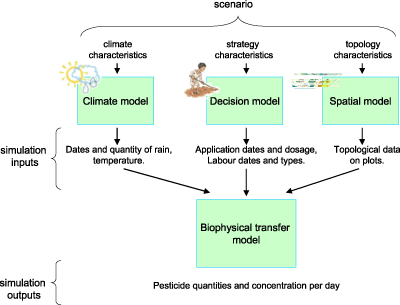
This issue in pdf Subscription Archive: Next issue: July 2005 |
|
||||
SACADEAU: A Decision-Aid System to Improve Stream-Water Qualityby Marie-Odile Cordier Water quality is a critical environmental issue. In this project, we use a pesticide transfer model to simulate effects on the quality of stream-water. Since a large number of parameters are involved in pollution phenomena, modelling, simulation and machine learning are useful techniques for acquiring knowledge in this poorly understood domain. The objective of the SACADEAU is to build a decision-aid tool to help specialists in charge of catchment area management to preserve stream-water quality. This is done by coupling a qualitative transfer model (simulating pesticide transfer through the catchment area) with a qualitative management model (simulating farmers’ decisions concerning weeding strategies and herbicide application). This has two main advantages: it allows the impact of recommendations to be evaluated by simulating high-level scenarios, and it allows simulation results to be analysed by using machine learning and data mining techniques to discover discriminating variables and to acquire knowledge in this poorly understood domain. The experimentation site (the Fremeur catchment area) is located in Brittany, France and covers about seventeen square kilometres. A Transfer Model Coupled with Three Input Models
These are as follows:
Using the outputs of these three sub-models, a biophysical transfer model determines pesticide transfer from application locations, through the catchment area, to the river. The model takes into consideration all the possible ways in which rainwater can flow through the catchment area (run-off and leaching). A High-Level Language To simulate a scenario, a methodology was defined that consists in generating a large set of instances of the scenario. These instances are then simulated and the results generalized to give a qualitative description (in response to a qualitative question) using machine-learning techniques. For example, given the question above concerning the impact of application dates, a response could be: "Concentration peaks appear when pesticide application dates are close (less than two days) to significant showers (quantity > 10mm)". Learning from Simulation Results
First results have been obtained with a simplified model, and according to the experts, they show both expected and surprising relationships. For instance, concerning stream-water quality, a post-emergence weeding strategy did not show better results than a pre-emergence strategy. This was unexpected, and a discussion on the impact of weeding strategies was generated, with some possible explanations given by experts. Future work is three-fold, and involves validating the model, refining the high-level language, and providing recommendations to experts based on relationships discovered through the model. The SACADEAU project is in its third year of development. Contributing members are M. O. Cordier, V. Masson, A. Salleb (IRISA/Univ. Rennes 1, Rennes), C. Gascuel-Odoux, F. Tortrat, P. Aurousseau, R. Trepos (INRA-ENSAR/UMR SAS, Rennes), F. Garcia (INRA/BIA, Castanet Tolosan), B. Chanomordic (INRA/LASB, Montpellier), M. Falchier, D. Heddadj and L. Lebouille (Chambre d'agriculture de Bretagne). SACADEAU is funded by Conseil Général du Morbihan and INRA. Link: Please contact: |
||||


